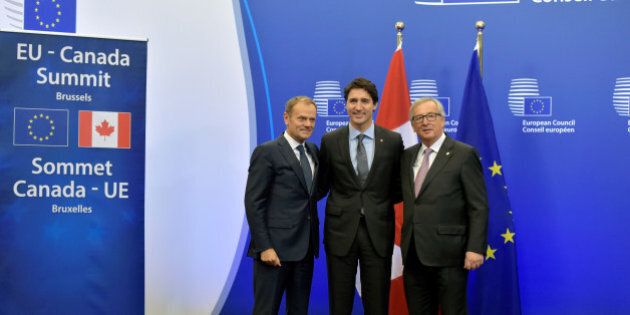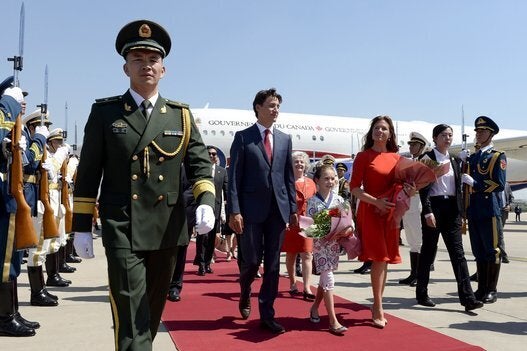
The big story with the Canada European Union Comprehensive Economic and Trade Agreement (CETA) is not that the agreement was finally signed; it is how well Canada has done on all fronts.
The bottom line is that Canada now appears as the only 'adult' in the room when it comes to global trade negotiations. Should the U.S. continue to fail and flail in its attempts to bring the TPP to a vote, that comparative distinction will carry through to Asian countries looking to pick up the pieces of a failed TPP and gain access to the NAFTA market.
This is a stunning reversal over how things looked seven years about when Canada began negotiations with the EU on CETA.
When negotiations for the CETA began, the EU expressed worries that Canadian provinces could refuse to go along with the agreement and waste years of negotiations. Similar concerns about the Canadian federal government's ability to bring its unruly and independent provinces to the table have been expressed by countries trade partners in Asia who view Canadian provinces more as emirates than U.S. states.
But rather than wrecking the negotiations having the provinces integrated into the negotiating process, in hindsight and in comparison to the current mess in Belgium, turns out to have been a brilliant move. The provinces played a constructive role at the negotiating table; something they have done in previous agreements.
Provincial governments tend to be seen as closer to the ground and more attuned to the concerns of their citizens. As a result, the text -- although still opposed by some -- is generally being well-received in Canada. Provincial officials also have technical expertise about trade issues tied to provincial industries that Ottawa lacks.
And irony of irony, rather than a Canadian province going rogue on the deal, as the EU feared, it was a Belgian sub-national government that almost tanked the treaty and wasted seven years of hard work.
At some point during the signing ceremony Canadian negotiators need to remind the EU about the old adage of the pot and the kettle.
The CETA ratification process of course was never supposed to come to this. Partly as a response to the populist pressure spurred by Brexit and partly by increasing concerns over the nature of the EU's trade relations with third parties (namely, the U.S. and its tumultuous TTIP negotiations), EU leadership decided each member state should have an equal say in the fate of the CETA. It was just in July that the EU -- under pressure to make negotiations appear more grass roots- made CETA a 'mixed agreement.' Such agreements require unanimous approval by all 28 EU 28 member states.
Canadian trade negotiators have embraced the reality that negotiations between two or more governments involve give and take.
In Belgium, this required three sub-national governments to give their approval before the nation can sign off on the agreement. Wallonia, one of these three sub-governments, balked.
In the U.S. the problem is not sub-national governments it is internal political divisions at the national level and in Washington DC. Regardless, the results, and worries for any potential US negotiating partner, are the same.
But Canada by contrast has emerged looking like a competent and dependable trading partner, a reputation that will pay dividends in the future.
Western Canada, in particular, is hoping the news on CETA is being translated into Mandarin, Japanese and the languages of the Association of Southeast Asian Nations.
Canada has proven it can negotiate with a unified and coherent position internationally, even when faced with concerns from certain provinces, sectors and advocacy groups. For all the differences among the provinces, especially in relation to the diversity of dominant industries, Canada can produce an agreement, rally domestic voices around it, and deliver on its promises.
Further, Canadian trade negotiators have embraced the reality that negotiations between two or more governments involve give and take. Whether the concerns are from powerhouses like Germany or even smaller powers like Bulgaria and the Czech Republic, certain concessions had to be made. Of course, when negotiating with the largest trading bloc in the world, there has to be a higher tolerance for what can be sacrificed. In modern trade negotiations, that means working with sub-national governments to build support for these bargains up front, rather than at the last minute as the EU attempted.
The CETA is a good agreement for Canada, made better by the concessions that arose from consulting with those most in touch on the ground, namely the provinces. Those who are going to be most affected by the CETA have had their voices heard. Canada has benefited from this consensus approach, and needs to make this the standard for future trade negotiations.
As Canada enters tougher trade negotiations in Asia, what many thought was a weakness in Canada's negotiating position -- having the provinces participate -- is turning out to be a strength, one that will help it jump to the head of negotiating queue as the U.S. continues to shoot itself in the foot.
The question though remains if the government in Ottawa is prepared to seize this opportunity.
Follow HuffPost Canada Blogs on Facebook
Also on HuffPost:
